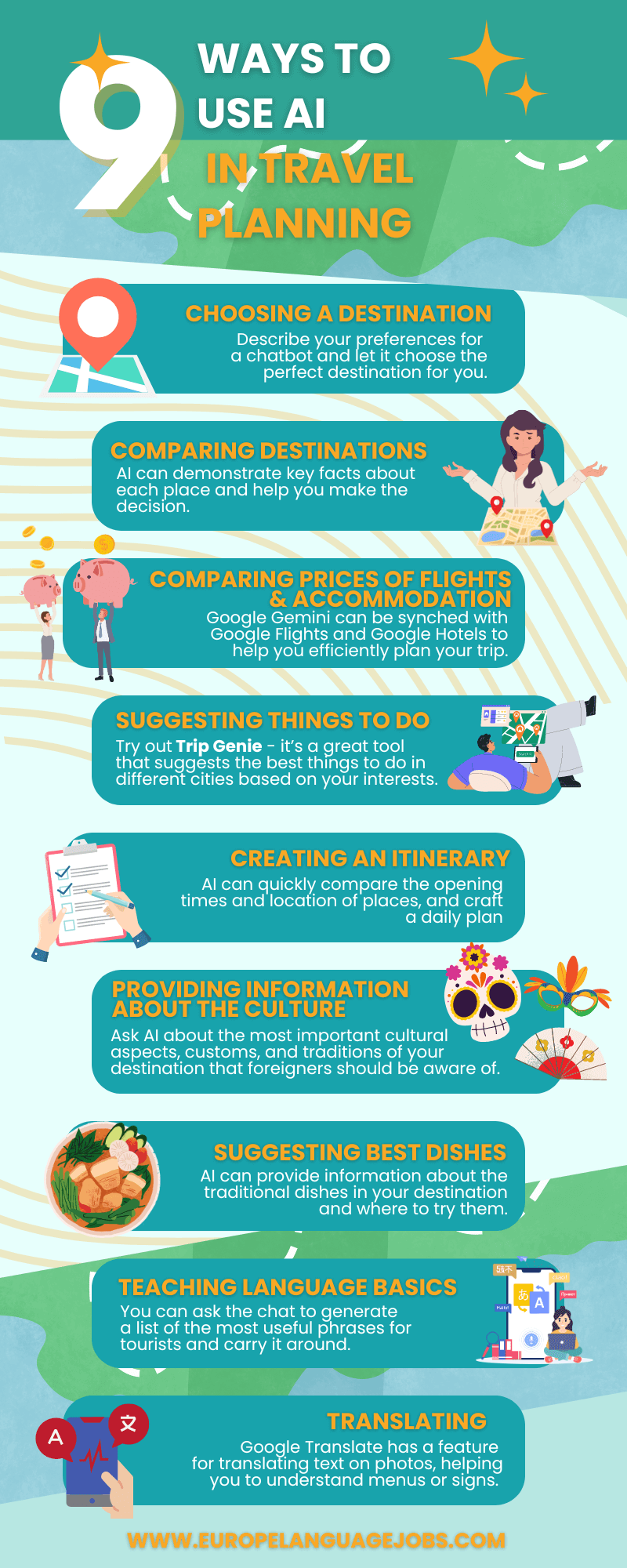Planning a trip is a very complex process. Some of us love it and could do it for a living, others hate it and would rather pay someone else to do it for them.
If you belong to the latter group: what if we told you that you don’t have to pay for assistance in travel planning? With the light-speed development of AI, it can progressively handle more and more of the heavy lifting that comes with planning a trip.
This article will explain how to use AI in travel planning and show you how to benefit from modern tools on every step of your journey.

How to use AI for travel planning
- Choosing a destination
- Comparing destinations
- Comparing prices of flights and hotels
- Suggesting the best things to do and places to see
- Creating an itinerary
- Providing information about the culture
- Suggesting the best dishes to try and where to try them
- Teaching the basics of the local language
- Translating

1. Choosing a destination
Some of us have a bucket list of destinations and just tick them off after every trip. But things are not as simple for those who know they would like to go somewhere but have no idea where.
We hear you, we are here for you, and want you to know that it’s completely fine!
At Europe Language Jobs, we know that there are just too many destinations to pick from. The world is your oyster, and deciding where to go and when can feel like a lot of pressure.
Gone are the days when you had to read through guides, scroll through photos, and ask friends for recommendations. Of course, you can still do all those things, but now, there is also one more tool to your advantage: AI.
Describe your preferences for a chatbot and let it choose for you. The more information you include, the more tailored answer it will provide, so answer the following questions in your prompt:
-
Who are you travelling with? Family, friends, partner, solo?
-
What kind of activities do you like? (sightseeing, partying, food, sports, sunbathing, art, history, nature, etc.)
-
What type of holiday are you interested in? (camping, hotel, beach holiday, adventure holiday, city break, romantic getaway, backpacking, all-inclusive, etc.)
-
How long would you like to go for?
-
How far are you willing to travel?
-
Which means of transport would you like to use to get there?
-
What time of the year do you plan to go?
-
What kind of climate and temperature do you expect?

2. Comparing destinations
Are you on the fence about where to go on your holiday? Maybe there are too many destinations to choose from and all of them sound equally tempting?
AI for travel can help you with that.
While it can’t be judgemental, it can demonstrate key facts about each place and help you make the decision.
Again, remember to be as specific as possible to get an answer tailor-made to your needs. Here is an example of a prompt:
Which destination is better for a family holiday with 2 small kids including sightseeing, beach and activities to do together as a family? Compare and contrast Sevilla, Spain and Bari, Italy in terms of attractions, accommodation, cost, and transport from Hamburg, Germany.
We tried this exact prompt and we have to admit, the answer was more complex than expected. Of course, it isn’t exhaustive and should be followed by further independent research, but it can help make the final decision.

3. Comparing prices of flights and hotels
When you know where you’re planning to go, it’s time to book flights and accommodation. It is the most stressful part of planning a trip because it requires extensive research and - horror of horrors - spending money. Needless to say, it is best to get it out of the way ASAP.
Google Gemini provides a good solution to take some of the stress out of researching and booking flights and accommodation. The chatbot can be synched with Google Flights and Google Hotels to help you efficiently plan your trip using AI.
Once you register, make sure to go to settings and enable Gemini access to the Flights and Hotels tools. This way, if you create a prompt, the chat will provide you with direct options with pricing and dates.
This is a clear advantage over many other chatbots, such as ChatGPT, which don’t possess the ability to search the web in real-time or provide updated information about available hotels, flights, or pricing.

4. Suggesting the best things to do and places to see
Once you choose your destination, it is time to decide what you’re going to do there. The best way to start is to compile a list of things to do and places to see, and choose the ones that seem the most appealing to you.
There are hundreds of guides created by travel bloggers for every destination you can imagine: “X best things to do in Y”. They are great, but you usually have to go through a few of them to discover all of the attractions a place has to offer, as they all focus on different things.
It can be fun if you like planning trips, but tiring if you don’t. The advantage of using AI for travel planning is that it can scan all those guides in seconds. You can get a comprehensive summary of a research that would have normally taken you hours with just one smartly-created prompt.
Try out Trip Genie - it’s a great tool that suggests the best things to do in every city in the world based on your interests. All you need to do is answer two questions, and you’ll get a custom-made list of interesting places.

5. Creating an itinerary
Flights and accommodation are booked, and the list of things to do is ready. Well done!
Now it’s time for the second most disliked part of planning a trip: creating an itinerary. Many people hate calculating which places should be visited when in terms of opening times and location.
If you happen to be one of those people - don’t worry! You can use AI for travel planning to create an itinerary from the list of things you’d like to do. While many chatbots don’t have the option to surf the web in real time, they have access to general information such as the official sites of museums and other tourist attractions.
They can quickly compare the opening times and locations of places, and craft a daily plan to help you make the most out of your trip.
In order to use AI in travel planning, upload the list of places to see and things to do and ask it to turn it into an x-day itinerary, taking into consideration the opening times and proximity of the places. It
Disclaimer: remember that if you are using a chatbot without access to real-time information, it may not be aware of temporary closures of places, for example for renovation. We advise you to double-check the information it provides to avoid disappointment.

6. Providing information about the culture
At Europe Language Jobs, we believe that research about the local customs and culture is a crucial aspect of preparing for a trip.
Being aware of the customs ensures you are tolerant and behave accordingly - it can also help you avoid embarrassment if you were to commit a faux pas.
Knowing about the traditions also allows you to get the best out of your experience. You may not be aware of some of the very cool things that are common in your destination and leave without trying them out.
The term “research” implies a lot of time spent digging through various resources, but AI for travel planning makes it easy. Just ask your chatbot of choice about the most important cultural aspects, customs, and traditions of your destination that foreigners should be aware of.

7. Suggesting the best dishes to try and where to try them
To all the foodies out there - we can all agree that sampling local cuisine is one of the most exciting aspects of travel. But how to know which dishes to try?
Enter AI.
You can unlock an entire menu by asking AI about the traditional dishes in your destination. AI is also a good way to ensure which of them are safe if you have certain dietary restrictions such as keto, veganism/vegetarianism, or lactose/glucose intolerance.
We recommend going a step further and asking AI where to try those dishes. It can scan thousands of reviews in seconds and provide you with a list of the most praised restaurants within your price range.

8. Teaching the basics of the local language
Just like researching the culture, learning some of the basic phrases in the local language is a must before every trip. They can be the simplest things such as “please”, “thank you”, and “where is the toilet?”.
Knowing a bit of the language can go a long way in communicating with locals. First of all, don’t assume that everyone speaks English wherever you go. They don’t. So, knowing even the most basic terms and phrases will make your life easier.
Second of all, locals appreciate it when tourists make the effort to speak their language. Remember that you are a guest, so it is a good way to show your respect.
If you use AI for travel planning, you have no excuse not to learn the basics. You can ask the chat to generate a list of the most useful phrases for tourists and get it in seconds. You don’t even have to learn them by heart if you don’t want to - just carry it around during your trip and access it when needed.

9. Translating
The role of AI in translation is controversial, and it is surely nowhere near good enough to replace skilled human translators anytime soon.
However, using AI in travel can be great for translating small things on your trips. Even actions as simple as ordering a meal can be tricky if you don’t know what you’re ordering, as there isn’t an English menu available.
Google Translate comes to the rescue in situations like that with its wonderful feature of translating text on photos. All you have to do is submit a picture or scan the text you want translated, and it will automatically translate it for you.
Of course, the translation will be awkward and will often still require some mental gymnastics to figure out why there is a thief on the menu*. But, let’s be honest, it is better than nothing, and it can bring on a good laugh.
*In Spanish, chorizo means a type of traditional sausage in the formal language, but it can also mean “thief” in slang.
There are many ways to use AI in travel planning. It can give you recommendations, compare prices of flights and accommodation, create an efficient itinerary, or provide language help.
Notice that it is worth using different chatbots, because some of them have an advantage over others in specific areas. For example, Google Gemini is the best for looking up the prices of flights and hotels, and ChatGPT is good at creating itineraries.
The process has never been easier, so take advantage of it and start planning your next trip!
Feeling inspired? Visit our blog for more career advice! How can you be sure the information we provide is top-notch? We are a group of professionals working with recruiters, career coaches, and HR specialists from all over the world!
Trust our experience and let us help you find a new job in Europe!























Andreas Papakanellou3w ago
Awesome! Maybe one day booking flights will be so easy even my dad will be able to do it on his own :)
Awesome! Maybe one day booking flights will be so easy even my dad will be able to do it on his own :)